| 
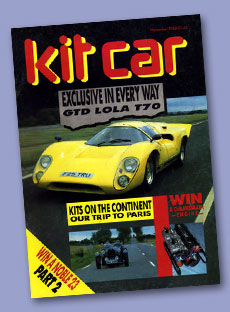 Two
years after he wrote his first preview of the Latham
F2, Ian Hyne revisited Latham Sports Cars to have a
look at Paul Latham Jackson's original, and by this
stage, rather weary prototype. . . Two
years after he wrote his first preview of the Latham
F2, Ian Hyne revisited Latham Sports Cars to have a
look at Paul Latham Jackson's original, and by this
stage, rather weary prototype. . .
It's
been a long time coming but, overlooking the shortcomings
of a hardworked prototype development car, Ian Hyne
thinks the Latham F2 has a good deal to offer as a high
performance, touring car.
The name Paul Latham Jackson will be familiar to many
a long term kit car enthusiast as the name behind Specialist
Cars in Souldern, Oxfordshire who produced some superb
examples of good quality kits from 1981 onwards. I suppose
their most publicised efforts were a pair of NG TCs
that they built for export which, as well as being the
first V8 powered cars and overcoming all the problems
caused by differences between MG and Rover engines,
were also excellent examples of what could be achieved
with a little careful thought and imagination.
It is those same qualities that make the Latham F2 such
a hot prospect for future success even though the prototype
currently features many aspects which require improvement.
The idea for the car was hatched a long time ago while
the current car has emerged after four years dedicated
research and development. Indeed, it was Paul's experience
at Specialist Cars that prompted him to take his ideas
one step further. At that time, he built only the kits
which he considered to be worth the effort while his
contact with the industry showed him much that was very
primitive and of poor quality. He reasoned that there
was a demand for something more sophisticated than the
batch of period roadsters that seemed to head the field
in terms of quality and popularity so he set to work.
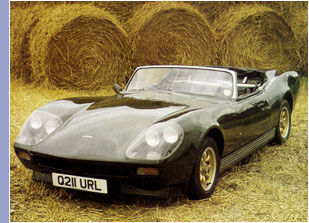 The
design parameters were many. The car had to be an open
two seater with room behind the seats for, as the blurb
so neatly puts it, 'the odd baggage or baby', it had
to be capable of accepting a hardtop for all year round
use, it had to have an easy to operate hood, it had
to have a decent sized boot sufficient to carry a couple
of weeks touring luggage, it had to have at least 100
bhp on tap and be smooth and light enough not to cost
a fortune in petrol. In addition, it had to be practical,
good looking, fast and relatively cheap and it had to
be fresh for the chap who didn't want to go round explaining
his car as a lesser copy of something else. (Click
image right to view enlargement) A tall order but
does the car live up to it? I think it does. The
design parameters were many. The car had to be an open
two seater with room behind the seats for, as the blurb
so neatly puts it, 'the odd baggage or baby', it had
to be capable of accepting a hardtop for all year round
use, it had to have an easy to operate hood, it had
to have a decent sized boot sufficient to carry a couple
of weeks touring luggage, it had to have at least 100
bhp on tap and be smooth and light enough not to cost
a fortune in petrol. In addition, it had to be practical,
good looking, fast and relatively cheap and it had to
be fresh for the chap who didn't want to go round explaining
his car as a lesser copy of something else. (Click
image right to view enlargement) A tall order but
does the car live up to it? I think it does.
As well as his experience of building kits, Paul has
also had the opportunity of driving a wide variety of
cars from competition Ferraris right down to the tattiest
Midget while he also spent a couple of years driving
a Davrian as his personal everyday transport. The car
was a glassfibre monocoque propelled by a Hillman Imp
engine and it was extremely successful in modsports
racing,' beating everything except heavily modified
Elans with far more power on tap. Having conducted experiments
with various chassis for his car, Paul then began to
wonder whether the same principles would ensure the
success of a larger car with a heavier engine, thus
the monocoque route was chosen.
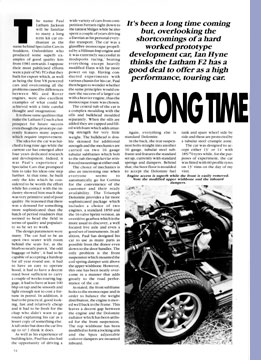 The
central tub of the car is a complex moulding with the
sills and bulkhead moulded separately. When the sills
are added they are capped and filled with foam which
adds amazing strength for very little weight. The bulkhead
is double skinned for additional strength and the mechanics
are carried on two 16 gauge tubular subframes which
bolt to the tub through kevlar reinforced mountings
at either end. The
central tub of the car is a complex moulding with the
sills and bulkhead moulded separately. When the sills
are added they are capped and filled with foam which
adds amazing strength for very little weight. The bulkhead
is double skinned for additional strength and the mechanics
are carried on two 16 gauge tubular subframes which
bolt to the tub through kevlar reinforced mountings
at either end.
The choice of mechanics is also an interesting one when
everyone seems to automatically go for Cortina for the
convenience of the customer and their ready availability.
The Triumph Dolomite provides a far more sophisticated
package which includes a choice of two engines, a standard
1850 and the 16-valve Sprint version, an overdrive gearbox
which is the more usual to discover, a well located
live axle and even a good set of instruments. In addition,
Paul has designed his car to use as many parts as possible
from the donor even down to the door handles. The only
problem is the front suspension which mounted the coil
spring damper unit above the upper wishbone. However,
this one has been neatly overcome in a manner that adds
greatly to the road performance of the car (see
inset photo left, where the inboard dampers and rocker
arm can just be made out).
As stated, the front subframe bolts to the monocoque
and in order to balance the weight distribution, the
engine is moved well back in the frame. This leaves
a decent gap between the engine and the Dolomite radiator
which has been utilised for the front suspension. The
top wishbone has been modified to form a rocking arm
and the Spax adjustable coilover dampers are mounted
inboard.
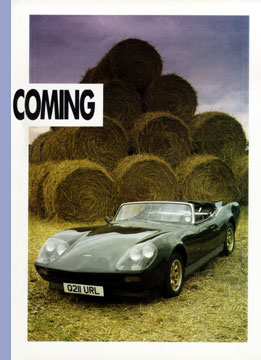 Again,
everything else is standard Dolomite. At the back, the
rear suspension bolts straight into another 16 gauge,
tubular steel sub-frame and features the standard set
up, currently with standard springs and dampers. Behind
that, the boot floor is moulded to accept the Dolomite
fuel tank and spare wheel side by side and these are
protected by a tubular steel crumple zone. Again,
everything else is standard Dolomite. At the back, the
rear suspension bolts straight into another 16 gauge,
tubular steel sub-frame and features the standard set
up, currently with standard springs and dampers. Behind
that, the boot floor is moulded to accept the Dolomite
fuel tank and spare wheel side by side and these are
protected by a tubular steel crumple zone.
The car was designed to accept either 13' or 14' with
185/70 tyres while, for the purposes of experiment,
the car was fitted with 60 profile tyres on 13' rims
on the day of my visit.
The body design is also unique. To my mind it presents
a pleasingly flowing shape which will improve with the
fitment of the larger wheels and tyres, The bonnet is
a one piece, forward hinging unit which incorporates
the inner wheel arches. It is easily detatched from
the car by pulling two pip pins to afford unrestricted
access to the engine. The only slight criticism was
that the day I drove it was a little windy and it moves
about a great deal when raised so perhaps a little more
stiffness would not go amiss while the fixings when
closed, which comprise the Dolomite spring catch and
a Dzus fastener either side, still allow it to move
about. Of course, there is no danger but it is a little
disconcerting nevertheless.
Moving back, the screen is MGB and the bonnet sweeps
up at the base to conceal the wipers. Behind the screen,
the dashboard, houses all the Dolomite clocks, heater
controls, ash tray, fresh air vents and stereo recess.
The main clocks are grouped in front of the driver along
with the Triumph multi warning light cluster and the
hazard warning switch. To the left, the three auxilliary
clocks are ranged above the manual switch for the Kenlowe
electric fan. Further over the heater controls are sandwiched
between the clock and a map light while below, the rest
of the bits and pieces are fitted into a specially designed
centre console.
The seats are excellent. They look very similar to Lotus
Elan but are the product of Latham Sports Cars while
the driving position is fine, if a little light on legroom
for the taller driver.
Behind
the passenger space, the boot sweeps up in a feature
now common on production cars as it allows the boot
space to be significantly increased and this car is
no exception giving a very good 11 cubic feet while
the boot, released from inside the car, also plays host
to the fuel filler.
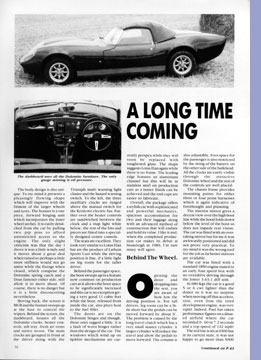 The
doors are on the Dolomite hinges and though, these ones
sagged a little, it is a fault of worn hinges rather
than the design of the car. The windows, which wind
up on Spitfire mechanisms, are currently Perspex while
they will soon be replaced with toughened glass. The
shape suggests Lotus Elan again while there is no frame.
The leading edge features an aluminium channel but this
will be in stainless steel on production cars as a better
finish can be achieved and the end caps are easier to
fabricate. The
doors are on the Dolomite hinges and though, these ones
sagged a little, it is a fault of worn hinges rather
than the design of the car. The windows, which wind
up on Spitfire mechanisms, are currently Perspex while
they will soon be replaced with toughened glass. The
shape suggests Lotus Elan again while there is no frame.
The leading edge features an aluminium channel but this
will be in stainless steel on production cars as a better
finish can be achieved and the end caps are easier to
fabricate.
Overall, the package offers a stylish car with sophisticated
and powerful mechanics, spacious accommodation for two
and their luggage along with an advanced method of construction
that will endure and hold its value. I like it and,
when the completed production car makes its debut at
Stoneleigh in 1989, I'm sure many will agree.
Behind The Wheel
Opening
the door and dropping into the seat, you are aware of
how low the driving position is. For tall drivers, legroom
can be a little short but the pedals can be moved forward
by about six inches. The problem is caused by the long
travel clutch which has a very small master cylinder.
A larger cylinder will reduce the travel and allow the
pedals to move forward. The column is also adjustable.
Foot space for the passenger is also restricted by the
siting of the battery on the other side of the bulkhead.
All the clocks are easily visible through the attractive
Dolomite wheel and the rest of the controls are well
placed. The chassis frame provides mounting points for
either three or four point harnesses which is again
indicative of forethought and planning.
The
interior mirror gives a decent view over the high boot
line while the hood folds down below the level of the
boot so does not impede rear vision. The car was fitted
with an overtaking mirror but for me it was awkwardly
positioned and did not prove very practical. To my mind
it was the wrong tool for the job as far better mirrors
are available.
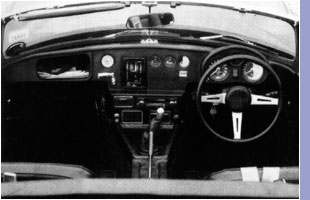 The
car was fitted with a standard 1850 engine mated to
an early four-speed box with no overdrive driving through
the lower 3.63:1 diff unit. At 680 kgs the car is a
good 5 or 6 cwt lighter than the donor so it was no
surprise when moving off that acceleration, even from
the tired development engine, was very rapid. Indeed,
Paul has taken performance figures on a disused airfield
where the car recorded 0 - 60 in 7.2 seconds and a top
speed of 122 mph! The red line is set at 6500 but in
its current state, it was not happy to go more than
5000 in the gears but that was plenty for rapid progress
round the lanes of Oxfordshire. The
car was fitted with a standard 1850 engine mated to
an early four-speed box with no overdrive driving through
the lower 3.63:1 diff unit. At 680 kgs the car is a
good 5 or 6 cwt lighter than the donor so it was no
surprise when moving off that acceleration, even from
the tired development engine, was very rapid. Indeed,
Paul has taken performance figures on a disused airfield
where the car recorded 0 - 60 in 7.2 seconds and a top
speed of 122 mph! The red line is set at 6500 but in
its current state, it was not happy to go more than
5000 in the gears but that was plenty for rapid progress
round the lanes of Oxfordshire.
On smooth roads, the car was a joy but come the bumps,
it seemed very harsh and rattly; unusual in a monocoque
design. However, ignoring the noise and the occasional
grounding of the skid plates. I pressed on.
It was a pleasure to drive a car fitted with a large
wheel as I always feel far more relaxed in control while,
on the handling side, the front end was superb pitching
into anything it was aimed at with well controlled enthusiasm
and minimal roll. The steering felt good and the column
transmitted marvellous feel. However, the rear end is
currently one inch lower than the production cars will
be and this, combined with the experimental fitting
of the 60-profile tyre, caused the bottoming. In addition,
the rear rode on standard springs and dampers which
we all agreed were too soft and, though I didn't push
it to break away, I felt it would not be difficult to
do, especially if fitted with the more powerful Sprint
engine.
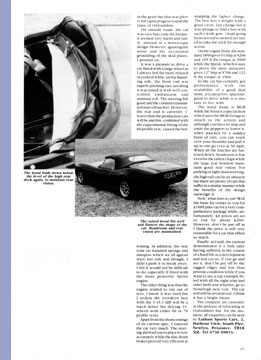 The
other thing was that the engine tended to run out of
revs. I know it was tired but I reckon the overdrive
box with the 3.45:1 diff will be a much better bet driving
14 inch wheels with either 60 or 70 profile tyres. The
other thing was that the engine tended to run out of
revs. I know it was tired but I reckon the overdrive
box with the 3.45:1 diff will be a much better bet driving
14 inch wheels with either 60 or 70 profile tyres.
Apart
from the shortcomings of its current spec, I enjoyed
the car very much. The steering allowed you to place
it very accurately while the disc / drum brakes proved
very efficient at stopping the lighter charge. The box
was a delight with a good clean, fast change but it
was strange to find a box with such a wide gate. I kept
going from second to neutral as I failed to take the
stick far enough across.
On
the engine front, the standard 1850 gives 91 bhp at
5200 and 105 ft lbs torque at 3500 while the Sprint,
which is sure to prove the more attractive gives 127
blip at 5700 and 122 ft lbs torque at 4500.
So the car has certainly got performance with the availability
of a good deal more, it is attractive, spacious, good
to drive while it is also easy to live with.
The
hood frame is MGB while the hood is a special item which
uses the MGB fixings to attach to the screen and although
you have to stop and undo the poppers to lower it, when
attacked by a sudden burst of rain, you can reach over
your shoulder and pull it up in one go even at 30 mph.
When all the hatches are battened down, headroom is
fine even for the tallest chaps while the large rear
window maintains good rear vision. For parking or tight
manoeuvring, the high tail can be an obstacle but there
are plenty of cars that suffer in a similar manner while
the benefits of the design outweigh it.
Now,
what does it cost? Well the basic kit comes to you for
£1695 plus vat for a very comprehensive package
while, unfortunately, kit prices are set to rise by
about £200. However, don't be put off as I think
the price is still very reasonable for a car that offers
so much.
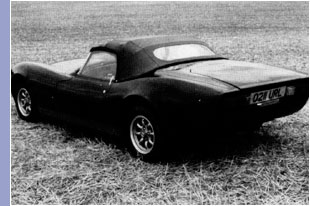 Finally,
as I said, the current demonstrator is a little tatty
having suffered in the course of a hard life as a development
and test car so, if you go and see it, don't be put
off by the ragged edges and less than pristine condition
while if you want to see a top example fitted with all
the right trim and other bells and whistles, go to Stoneleigh
next year. The car will still be around and, I think
it has a bright future. Finally,
as I said, the current demonstrator is a little tatty
having suffered in the course of a hard life as a development
and test car so, if you go and see it, don't be put
off by the ragged edges and less than pristine condition
while if you want to see a top example fitted with all
the right trim and other bells and whistles, go to Stoneleigh
next year. The car will still be around and, I think
it has a bright future.
The
company are currently in the process of relocating in
Oxfordshire but, for the moment, all enquiries can be
sent to . . .
With
thanks to Ian Hyne
Kit Car Magazine, November 1988, pages 54-56/63
Paul's
car remained the only F2 for some little while, even
after this article was written, and he continued to
delight in throwing the nimble beast around the back
lanes of Oxfordshire. Tired it may have been, but the
1850 engine continued for several more years, and the
car never did get the larger wheels, or stiffer springs,
that Ian Hyne wanted. Paul still has the car, and has
been talking about restoring it for some (not inconsiderable)
time.
 To
visit the website of the current Kit Car magazine, click
this old version of the logo: To
visit the website of the current Kit Car magazine, click
this old version of the logo:
|